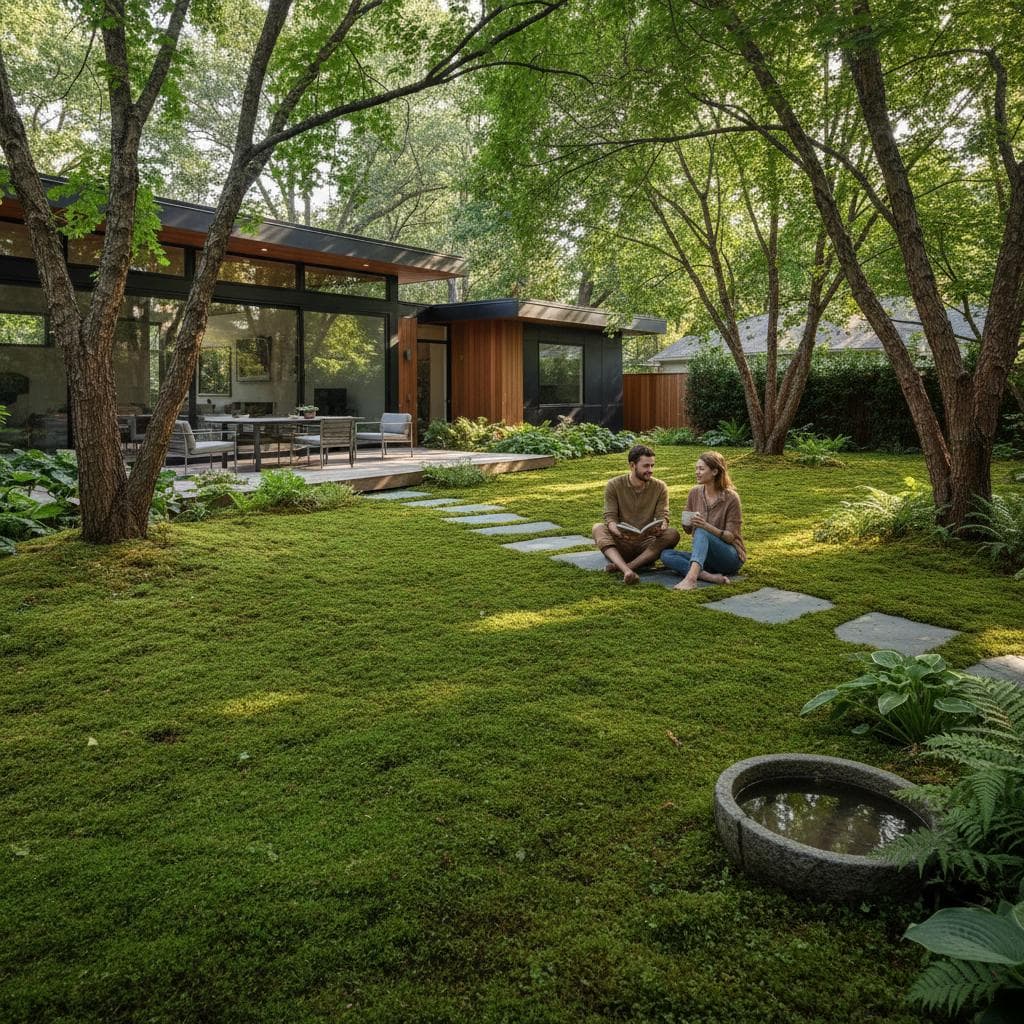Moss Lawns on the Rise: A Sustainable Yard Transformation
Homeowners often spend hours each week on lawn care tasks such as mowing, watering, and applying fertilizers. A moss lawn presents a compelling alternative that eliminates these demands while providing a lush, inviting surface. In regions like California, where water conservation ranks high, moss aligns perfectly with efforts to create harmonious, low-impact landscapes that blend modern aesthetics with enduring natural beauty.
Reasons Moss Lawns Gain Popularity
Moss lawns supplant traditional grass by offering a surface that flourishes in conditions unfavorable to turf. They require no fertilizers, minimal watering after establishment, and zero mowing. This coverage remains vibrant throughout the year, including during periods of low rainfall, which suits shaded areas, coastal environments, and designs inspired by woodlands.
Moss lacks true roots and instead draws nutrients and water through its leaf-like structures. This adaptation allows it to prosper on compacted, rocky, or nutrient-poor soils where grass typically fails. The outcome yields a durable, plush expanse that provides a gentle texture underfoot and integrates seamlessly with the natural surroundings.
Environmental Advantages of Moss
Moss lawns contribute to ecological balance in multiple ways. They remove the reliance on fuel-consuming mowers and minimize pollution from chemical treatments. By retaining water within its structures, moss stabilizes soil, enhances local moisture levels, and fosters a more temperate environment in yards.
In drought-vulnerable locations, these lawns substantially cut water consumption. Established moss only requires supplemental moisture during prolonged dry conditions. Homeowners thus maintain an attractive, verdant yard while adhering to conservation practices.
Selecting Appropriate Moss Varieties
Numerous moss species exist, each bringing unique qualities to a landscape. For lawn applications, consider these popular options:
- Sheet Moss (Hypnum): Provides uniform, flat coverage that spreads rapidly and withstands light foot traffic.
- Cushion Moss (Leucobryum): Develops into rounded, pillowy forms that introduce varied heights and visual depth.
- Fern Moss (Thuidium): Delivers a fine, fern-like frond structure ideal for moist, shaded woodland replicas.
Evaluate your site thoroughly prior to selection. Moss performs best in partial to full shade on firm soil with reliable humidity. Areas exposed to direct sunlight all day may cause excessive drying, so reserve moss for spots under tree canopies or beside north-facing walls.
Site Preparation and Installation Steps
Effective preparation forms the foundation of a thriving moss lawn. Begin by removing existing grass, weeds, and loose materials with a rake or sod cutter. Scarify the soil lightly to create texture for better adhesion, targeting a pH range of 5.0 to 6.0, which favors moss growth; use a soil test kit and add elemental sulfur if the reading exceeds 6.0.
For planting, gather moss from healthy patches or purchase transplants. Break it into small pieces or lay intact sheets directly onto the prepared surface, pressing firmly to ensure soil contact. Water immediately with a fine mist to saturate evenly, then maintain damp conditions for the initial two to four weeks by watering daily or as needed to prevent drying.
As moss attaches, it spreads via spores and fragments, filling gaps over time. Patience proves essential during this phase, as full coverage may take several months depending on climate and site conditions.
Essential Care Practices
Although moss demands little attention, targeted upkeep preserves its vitality. Follow these guidelines to sustain optimal appearance:
- Provide occasional watering. During extended dry periods exceeding two weeks, apply a light mist in the morning or evening to refresh without over-saturating.
- Clear surface debris. Employ a soft-bristled rake or low-speed leaf blower weekly to remove fallen leaves, twigs, or dust that could smother the moss.
- Manage foot traffic. Direct pathways with flat stones or mulch to concentrate wear, allowing moss to recover in low-use zones.
- Address weeds promptly. Pull emerging competitors by hand at the base, as moss's dense mat discourages deep rooting by intruders.
These routines require minimal time, often just 15 to 30 minutes monthly, yielding a pristine surface with little ongoing effort.
Combining Moss with Complementary Elements
Moss enhances diverse landscape designs through thoughtful pairings. It pairs elegantly with flagstone walkways, small ponds, or borders of shade-loving perennials. In styles drawing from Japanese traditions, moss evokes peace and maturity alongside minimalist rocks and gravel.
Incorporate ferns, astilbe, or wild ginger for added layers of foliage and color contrast. For yards with mixed light exposure, allocate moss to dimmer sections while planting sun-adapted options like lavender or yarrow in brighter spots. Such integration promotes biodiversity, conserves resources, and ensures cohesive visual appeal.
Experiencing the Benefits of Moss
An established moss lawn transforms daily interactions with outdoor spaces. Its cool, yielding texture invites barefoot strolls, while its sound-absorbing quality fosters quiet reflection. Over time, observe how it responds to seasonal shifts, deepening your appreciation for subtle environmental cues.
This choice redefines yard maintenance by prioritizing sustainability over labor. Through initial setup and basic care, achieve a resilient, evergreen haven that endures California's variable weather. Embrace moss to cultivate a space that nurtures both the land and your lifestyle.

